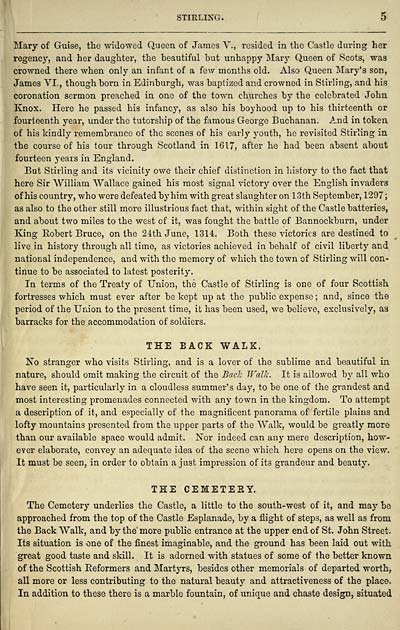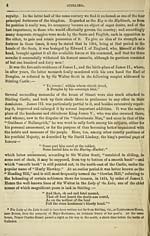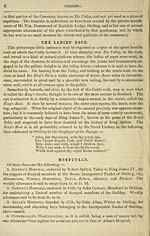Download files
Complete book:
Individual page:
Thumbnail gallery: Grid view | List view

STIRLING.
Mary of Guise, the widowed Queen of James V., resided in the Castle during her
regency, and her daughter, the heautiful but unhappy Maiy Queen of Scots, was
crowned there when only an infant of a few months old. Also Queen Mary's son,
James VI., though born in Edinburgh, was baptized and crowned in Stirling, and his
coronation sermon preached in one of the town churches by the celebrated John
Knox. Here he passed his infancy, as also his boyhood up to his thirteenth or
fourteenth year, under the tutorship of the famous George Buchanan. And in token
of his kindly remembrance of the scenes of his early youth, he revisited Stirling in
the course of his tour through Scotland in 1617, after he had been absent about
fourteen years in England.
But Stirling and its vicinity owe their chief distinction in history to the fact that
here Sir William Wallace gained his most signal victory over the English invaders
of his country, who were defeated by him with great slaughter on 13th September, 1297;
as also to the other still more illustrious fact that, within sight of the Castle batteries,
and about two miles to the west of it, was fought the battle of Bannockburn, under
King Eobert Bruce, on the 24th June, 1314. Both these victories are destined to
live in history through all time, as victories achieved in behalf of civil liberty and
national independence, and with the memory of which the town of Stii'ling will con-
tinue to be associated to latest posterity.
In terms of the Treaty of Union, the Castle of Stirling is one of four Scottish
fortresses which must ever after be kept up at the public expense ; and, since the
period of the Union to the present time, it has been used, we believe, exclusively, as
barracks for the accommodation of soldiers.
THE BACK WALK.
No stranger who visits Stirling, and is a lover of the sublime and beautiful in
nature, should omit making the circuit of the Bach Walk. It is allowed by all who
have seen it, particularly in a cloudless summer's day, to be one of the grandest and
most interesting promenades connected with any town in the kingdom. To attempt
a description of it, and especiallj' of the magnificent panorama of fertile plains and
lofty mountains presented from the upper parts of the Walk, would be greatly more
than our available space would admit. Nor indeed can any mere description, how-
ever elaborate, convey an adequate idea of the scene which here opens on the view.
It must be seen, in order to obtain a just impression of its grandeur and beauty,
THE CEMETEHY.
The Cemetery underlies the Castle, a little to the south-west of it, and may be
approached from the top of the Castle Esplanade, by a flight of steps, as well as from
the Back Walk, and by the more public entrance at the upper end of St. John Street.
Its situation is one of the finest imaginable, and the ground has been laid out with
great good taste and skill. It is adorned with statues of some of the better known
of the Scottish Keformers and Martyrs, besides other memorials of departed worth,
all more or less contributing to the natural beauty and attractiveness of the place.
In addition to these there is a marble fountain, of unique and chaste design, situated
Mary of Guise, the widowed Queen of James V., resided in the Castle during her
regency, and her daughter, the heautiful but unhappy Maiy Queen of Scots, was
crowned there when only an infant of a few months old. Also Queen Mary's son,
James VI., though born in Edinburgh, was baptized and crowned in Stirling, and his
coronation sermon preached in one of the town churches by the celebrated John
Knox. Here he passed his infancy, as also his boyhood up to his thirteenth or
fourteenth year, under the tutorship of the famous George Buchanan. And in token
of his kindly remembrance of the scenes of his early youth, he revisited Stirling in
the course of his tour through Scotland in 1617, after he had been absent about
fourteen years in England.
But Stirling and its vicinity owe their chief distinction in history to the fact that
here Sir William Wallace gained his most signal victory over the English invaders
of his country, who were defeated by him with great slaughter on 13th September, 1297;
as also to the other still more illustrious fact that, within sight of the Castle batteries,
and about two miles to the west of it, was fought the battle of Bannockburn, under
King Eobert Bruce, on the 24th June, 1314. Both these victories are destined to
live in history through all time, as victories achieved in behalf of civil liberty and
national independence, and with the memory of which the town of Stii'ling will con-
tinue to be associated to latest posterity.
In terms of the Treaty of Union, the Castle of Stirling is one of four Scottish
fortresses which must ever after be kept up at the public expense ; and, since the
period of the Union to the present time, it has been used, we believe, exclusively, as
barracks for the accommodation of soldiers.
THE BACK WALK.
No stranger who visits Stirling, and is a lover of the sublime and beautiful in
nature, should omit making the circuit of the Bach Walk. It is allowed by all who
have seen it, particularly in a cloudless summer's day, to be one of the grandest and
most interesting promenades connected with any town in the kingdom. To attempt
a description of it, and especiallj' of the magnificent panorama of fertile plains and
lofty mountains presented from the upper parts of the Walk, would be greatly more
than our available space would admit. Nor indeed can any mere description, how-
ever elaborate, convey an adequate idea of the scene which here opens on the view.
It must be seen, in order to obtain a just impression of its grandeur and beauty,
THE CEMETEHY.
The Cemetery underlies the Castle, a little to the south-west of it, and may be
approached from the top of the Castle Esplanade, by a flight of steps, as well as from
the Back Walk, and by the more public entrance at the upper end of St. John Street.
Its situation is one of the finest imaginable, and the ground has been laid out with
great good taste and skill. It is adorned with statues of some of the better known
of the Scottish Keformers and Martyrs, besides other memorials of departed worth,
all more or less contributing to the natural beauty and attractiveness of the place.
In addition to these there is a marble fountain, of unique and chaste design, situated
Set display mode to: Large image | Transcription
Images and transcriptions on this page, including medium image downloads, may be used under the Creative Commons Attribution 4.0 International Licence unless otherwise stated. ![]()
| Scottish Post Office Directories > Towns > Stirling > Threepenny guide & directory for Stirling, Bridge of Allan, etc. > (13) |
|---|
| Permanent URL | https://digital.nls.uk/85270366 |
|---|
| Description | Directories of individual Scottish towns and their suburbs. |
|---|
| Description | Around 700 Scottish directories published annually by the Post Office or private publishers between 1773 and 1911. Most of Scotland covered, with a focus on Edinburgh, Glasgow, Dundee and Aberdeen. Most volumes include a general directory (A-Z by surname), street directory (A-Z by street) and trade directory (A-Z by trade). |
|---|


